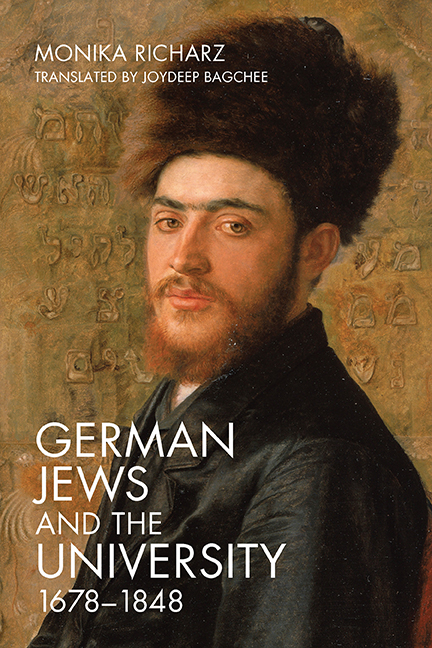Book contents
- Frontmatter
- Dedication
- Contents
- Foreword to the English Edition
- Foreword to the German Edition
- Preface to the German Edition
- Translator’s Note
- List of Abbreviations
- 1 Jewish Education in the Enlightenment Era
- 2 Jewish Encounters with the University before Emancipation
- 3 Jewish Students in the First Half of the Nineteenth Century
- 4 The Social Situation of Jewish Students in the pre-1848 Era
- 5 The Professional Experience of Jewish University Graduates
- Conclusion
- Documents
- Bibliography
- Index
Foreword to the English Edition
Published online by Cambridge University Press: 15 September 2022
- Frontmatter
- Dedication
- Contents
- Foreword to the English Edition
- Foreword to the German Edition
- Preface to the German Edition
- Translator’s Note
- List of Abbreviations
- 1 Jewish Education in the Enlightenment Era
- 2 Jewish Encounters with the University before Emancipation
- 3 Jewish Students in the First Half of the Nineteenth Century
- 4 The Social Situation of Jewish Students in the pre-1848 Era
- 5 The Professional Experience of Jewish University Graduates
- Conclusion
- Documents
- Bibliography
- Index
Summary
FROM THE MID-NINETEENTH CENTURY until the Holocaust, a Jewish academic elite stood out in Germany, making impressive achievements. The members of this elite were far more numerous than the proportion of Jews in the general population. Legal emancipation and the dramatic transformation of German society from a social, economic, and political system of estates to one of classes—two developments that were fueled by ideas of equality and enlightenment—enabled unprecedented social mobility for Jewish university graduates. The vast majority of these graduates adopted bourgeois values and acculturated to German society, while some of them converted to Christianity and became fully assimilated. Monika Richarz's important, impressive, and learned book asks the intriguing questions of how this group emerged and what its historical impact and importance was.
The answer to these questions is given on three levels, taking the reader along on a complex two-hundred-year journey from the midseventeenth century until 1848. On the first level, the book supplies a considerable amount of statistical information drawn from meticulous archival research in the matriculation records of German universities, the history of Jewish legislation, and the documents of the Jewish communities. From these archival sources and data Richarz reconstructs the story of the acceptance of Jewish students into universities from an institutional perspective. On the second level, her comparative research sheds light on the differences among the academic institutions that accepted Jews, calling attention to the social situation of the students and emphasizing the personal stories of several of the better-known students. It takes note of the successions of families of physicians and entrepreneurs and the gap between them and those who came from a lower, poorer social class.
This is mainly the story of Jews who overcame linguistic and cultural barriers and acquired secular knowledge in addition to traditional religious knowledge. Richarz's point of departure is traditional Jewish education and the religious ideals that formed it. The book then goes on to discuss the Jewish medical students and physicians of the seventeenth century and the growth in their numbers in the eighteenth century. At the end of this period the gates to general education were opened wide to the Jews in Germany, both in the Gymnasium and in the university.
- Type
- Chapter
- Information
- German Jews and the University, 1678-1848 , pp. ix - xivPublisher: Boydell & BrewerPrint publication year: 2022

